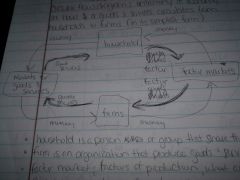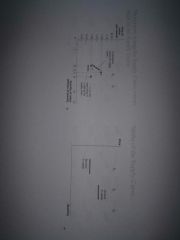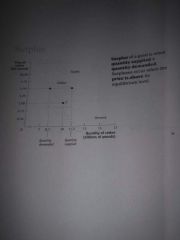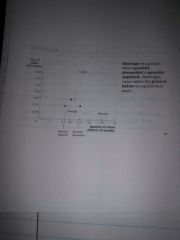![]()
![]()
![]()
Use LEFT and RIGHT arrow keys to navigate between flashcards;
Use UP and DOWN arrow keys to flip the card;
H to show hint;
A reads text to speech;
62 Cards in this Set
- Front
- Back
- 3rd side (hint)
|
Economics |
Is a social science that studies how people allocate their limited resources to satisfy their unlimited wants |
Resources are scarce. Our wants are not. |
|
|
Microeconomics |
Branch of economics concerned with how individuals, consumers, and firms make decisions and how these decisions interact |
|
|
|
Macroeconomics |
Branch of economics concerned with the overall ups and downs in the economy |
|
|
|
Market economy |
Economy in which decisions about production and consumption are made by individual producers and consumers |
|
|
|
Recession |
A small decrease in unemployment and rise in productions (prices) --Downturn in the economy |
|
|
|
Economic growth |
Increase in the output that an economy produces over a period of time |
Year: 2000 - 14 tons .........2001 - 15 tons .........2002 - 14.5 tons ........ 2003 - 17 tons |
|
|
Resource vs Good |
Car (personal use) = Good Car (TAXI) = Resource - produces money |
|
|
|
Opportunity Cost |
Value of the next best alternative The real cost of an item
OC = Give Up ........———— ........... Get |
|
|
|
Margin |
Means the change of one |
Think at the margin! Not" either or" but instead "how much" |
|
|
Self-interest |
One's personal interest of advantage; especially without regards to others |
|
|
|
Want |
Is what people could buy if their income is unlimited |
|
|
|
Economy |
A system of coordinating society's productive activities |
|
|
|
Market failure |
When the individual pursuit of self-interest leads to bad results for society |
|
|
|
Invisible hand |
The idea that the individual pursuit of self-interest can lead to good results for society as a whole |
|
|
|
Individual choice |
Is the decision by an individual of what to do, which necessarily involves a decision of what not to do |
|
|
|
Resource |
Anything that can be used to produce something else Are scarce |
Land, labor (time of workers), capital (machines) |
|
|
Principle 1 |
Resources are scarce |
|
|
|
Principal 2 |
Opportunity cost |
|
|
|
Principal 3 |
Marginal analysis |
|
|
|
Trade-off |
When you compare the costs with the benefits of doing something |
|
|
|
Marginal decisions |
Decision to do more or less of something |
|
|
|
Principal 4 |
Exploiting opportunities People respond to incentives |
anything that offers rewards to people who change their behavior |
|
|
Principle 5 |
Gains from trade |
|
|
|
Trade |
Individuals provide goods and services to others and receive goods and services in return |
|
|
|
Specialization |
When each person specializes in the task that he or she is good at performing |
|
|
|
Principle 6 |
Equilibrium |
|
|
|
Equilibrium |
Economic situation when no individual would be better off doing something different |
|
|
|
Principle 7 |
Efficiency vs Equity |
|
|
|
Efficiency |
Makes sure all opportunities to make people better off have been fully exploited |
|
|
|
Equity |
Makes life "fairer" for people Everyone gets his or her fair share |
|
|
|
Principle 8 |
Markets usually lead to efficiency |
|
|
|
Principle 9 |
Government intervention can improve society's welfare |
|
|
|
Economy Wide Interactions |
-One person's spending is another person's income -Overall spending can get out of line with the economy's productive capacity -Government policies can change spending |
|
|
|
Model |
Simplified representation of a real situation that is used to better understand real-life situations |
|
|
|
Production possibility frontier |
P. P. F A graph that shows two goods that the economy can produce given the current resources and technology |
|
|
|
Economic good |
Demand is greater than the supply when the price is equal to zero |
D > S = 0 |
|
|
Free good |
Supply is greater than the demand when the price is equal to zero |
S > D = 0 |
|
|
Scarcity |
When there is not enough of a resource available to satisfy all the ways a society wants to use it |
|
|
|
Economic agents |
Consumer or household Business or firm |
|
|
|
Factor market |
Land Capital Labor |
|
|
|
Circular flow diagram |
Anatomy of economy to see how money or goods and services circulates from households to firms (in its simplest form) |

|
|
|
Capital |
Means machinery and buildings |
|
|
|
Positive economics |
How the economy works positive statements; true statements "What if" statements |
|
|
|
Normative economics |
Way the economy should work Opinions What ought to be or What should be statements |
|
|
|
Competitive market |
Buyers and sellers can not have an impact One person has no effect Same goods |
This is an assumption in the economy |
|
|
Demand curve |
Graphical representation of the demand schedule |
|
|
|
Demand |
Relationship between quantity demand and the price of a good |
All else is equal |
|
|
Law of demand |
As the price increases the quantity of the demand falls |
P↗, Qd↘ or P↘ , Qd↗ |
|
|
Law of demand |
As the price increases the quantity of the demand falls |
P↗, Qd↘ or P↘ , Qd↗ |
|
|
Law of demand |
As the price increases the quantity of the demand falls |
P↗, Qd↘ or P↘ , Qd↗ |
|
|
Quantity demand |
Amount that consumers are buying at a given price |
|
|
|
What causes a demand curve change |
Change of price in related goods Change of income Change of tastes Change of expectations Change of # of customers |
|
|
|
Normal goods |
When a ride in income increases the demand of a good |
|
|
|
Inferior good |
When a rise in income decreases the demand for a good |
|
|
|
Comparative advantage |
A company has this if their opportunity cost of producing that good is lower compared to the other country |
|
|
|
Absolute advantage |
A country can make more output per worker compared to the other country |
|
|
|
Supply curve |
Graphical representation that shows how much of a good or service producers are willing to sell at any given price |
|
|
|
Law of supply |
As the price increases the quantity supply will also increase |
|
|
|
Causes a Supply curve shift |
Change in input Change in price of related goods and services Changes in technology Changes in expectations Changes in the number of producers |

|
|
|
Surplus |
Quantity supplied is greater than quantity demanded Occurs when the price is above it's equilibrium level |

|
|
|
Shortage |
Quantity demand is greater than the quantity supplied Occurs when the price is below its equilibrium level |

|
|
|
Normal goods |
When a rise in income increases the demand of a good |
|

